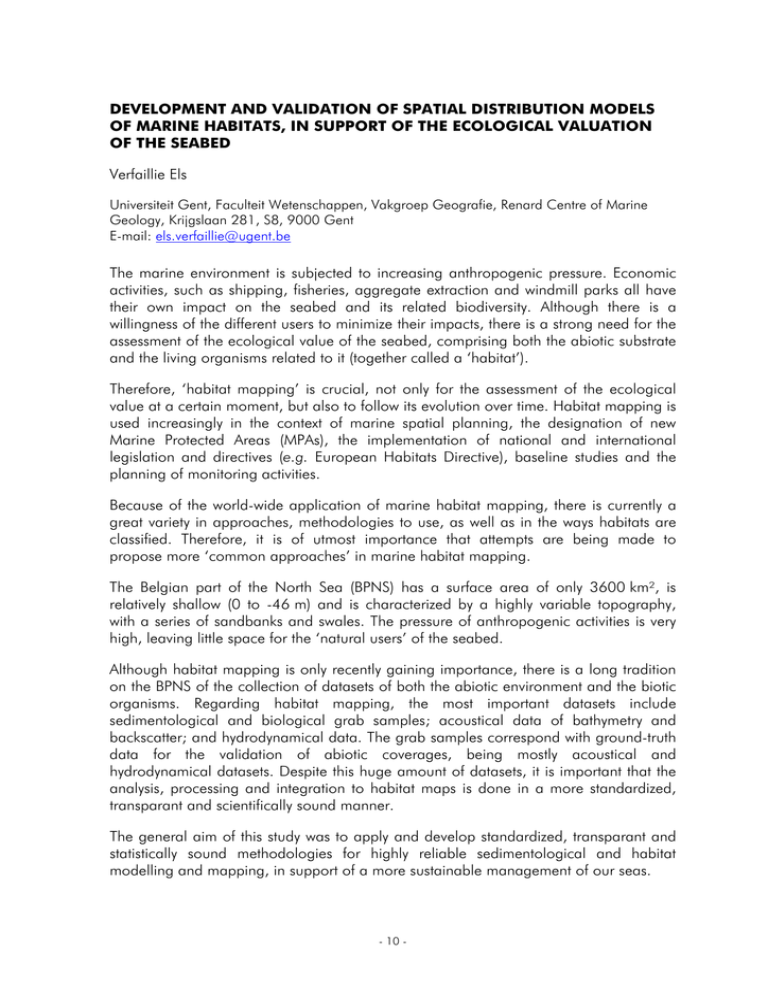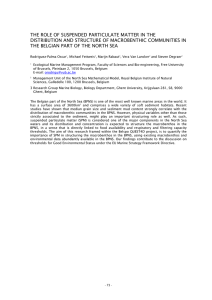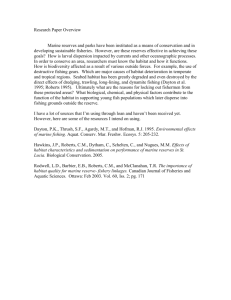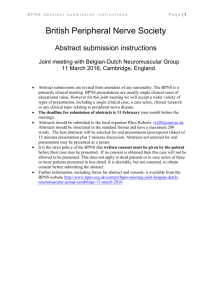DEVELOPMENT AND VALIDATION OF SPATIAL DISTRIBUTION MODELS
advertisement

DEVELOPMENT AND VALIDATION OF SPATIAL DISTRIBUTION MODELS OF MARINE HABITATS, IN SUPPORT OF THE ECOLOGICAL VALUATION OF THE SEABED Verfaillie Els Universiteit Gent, Faculteit Wetenschappen, Vakgroep Geografie, Renard Centre of Marine Geology, Krijgslaan 281, S8, 9000 Gent E-mail: els.verfaillie@ugent.be The marine environment is subjected to increasing anthropogenic pressure. Economic activities, such as shipping, fisheries, aggregate extraction and windmill parks all have their own impact on the seabed and its related biodiversity. Although there is a willingness of the different users to minimize their impacts, there is a strong need for the assessment of the ecological value of the seabed, comprising both the abiotic substrate and the living organisms related to it (together called a ‘habitat’). Therefore, ‘habitat mapping’ is crucial, not only for the assessment of the ecological value at a certain moment, but also to follow its evolution over time. Habitat mapping is used increasingly in the context of marine spatial planning, the designation of new Marine Protected Areas (MPAs), the implementation of national and international legislation and directives (e.g. European Habitats Directive), baseline studies and the planning of monitoring activities. Because of the world-wide application of marine habitat mapping, there is currently a great variety in approaches, methodologies to use, as well as in the ways habitats are classified. Therefore, it is of utmost importance that attempts are being made to propose more ‘common approaches’ in marine habitat mapping. The Belgian part of the North Sea (BPNS) has a surface area of only 3600 km², is relatively shallow (0 to -46 m) and is characterized by a highly variable topography, with a series of sandbanks and swales. The pressure of anthropogenic activities is very high, leaving little space for the ‘natural users’ of the seabed. Although habitat mapping is only recently gaining importance, there is a long tradition on the BPNS of the collection of datasets of both the abiotic environment and the biotic organisms. Regarding habitat mapping, the most important datasets include sedimentological and biological grab samples; acoustical data of bathymetry and backscatter; and hydrodynamical data. The grab samples correspond with ground-truth data for the validation of abiotic coverages, being mostly acoustical and hydrodynamical datasets. Despite this huge amount of datasets, it is important that the analysis, processing and integration to habitat maps is done in a more standardized, transparant and scientifically sound manner. The general aim of this study was to apply and develop standardized, transparant and statistically sound methodologies for highly reliable sedimentological and habitat modelling and mapping, in support of a more sustainable management of our seas. - 10 - To achieve these aims, this thesis is subdivided into two themes: 1) Best coverage data for habitat mapping; and 2) Integration of datasets in view of habitat mapping. The two themes consist out of two (Chapter 2 and 3) and three (Chapter 4, 5 and 6) papers. These were published in or submitted to peer-reviewed international journals. In Theme 1, emphasis is put on the creation of highly reliable sedimentological maps of the grain-size and the silt-clay percentage. The sedimentological maps are based on multivariate geostatistical techniques and more specifically Kriging with an external drift (Goovaerts, 1997). Because of a linear relation between the sedimentological point data and one or more secondary datasets, this secondary dataset can assist into the interpolation and improve the final result. In soft substrata sandy habitats, such as the BPNS, those coverages are crucial for the predictive modelling of macrobenthos (sea bottom inhabiting organisms larger than 1 mm) (e.g. Wu and Shin, 1997; Van Hoey et al., 2004; and Willems et al., 2008). In Chapter 2, the median grain-size of the sand fraction on the BPNS is interpolated with the bathymetry as secondary information. Chapter 3 applies the same methodology, but in a more advanced approach. Based on data from a small study area on the BPNS, four sedimentological variables are interpolated using a whole set of secondary variables. These variables are derivatives from the bathymetry and are calculated over different spatial scales. In both chapters, a validation against standard interpolation techniques reveals that the obtained results are significantly better than without the secondary information. The resulting maps reflect well the natural geomorphology of the seabed. In Theme 2, the sedimentological maps and other abiotic coverages are integrated to obtain habitat maps. In Chapter 4, a marine landscape map is produced, dividing the BPNS into discrete ecological units, based solely on geophysical data (Roff and Taylor, 2000). For a more objective selection of the abiotic coverages, various datasets are used and clustered. Principal Components Analysis allowed reducing the datasets avoiding correlation between the coverages. The optimal number of marine landscapes is defined by a statistical index. The validation of the internal cluster consistency shows that the result of the clustering of the abiotic coverages is very reliable. The ecological validation confirms the ecological relevance of the marine landscapes on the BPNS. In Chapter 5 and 6, habitat suitability models (HSMs) are developed, which indicate the suitability of a certain area for a specific species or community. Chapter 5 applies Discriminant Function Analysis (DFA), resulting in a HSM for the 4 macrobenthic communities on the BPNS, being species associations (the Macoma balthica, Abra alba, Nephtys cirrosa and Ophelia limacina community; Degraer et al., 2002; Van Hoey et al., 2004). A three-fold cross-validation and two validation indices show that the agreement between the model predictions and observations is very good and consistent. The HSM of the ecologically important A. alba community is the most - 11 - relevant model result, possibly serving as input for biological valuation (Derous et al., 2007) or for the designation of potentially valuable seabed habitats. Finally, in Chapter 6, Ecological Niche Factor Analysis is tested on the BPNS to predict the most suitable habitats of the species Owenia fusiformis. This species is capable of forming dense aggregations or patches and is one of the 10 most abundant species (ind.m-²) of the A. alba community (Fromentin et al., 1997; Van Hoey et al., 2004). The chapter demonstrates that not only sedimentological and bathymetrical coverages, but also multi-scale topographical coverages are important predictors of the occurrence of this species. Finally, in the Discussion, results are intercompared, overlain and integrated. The reliability of the habitat maps is calculated following a multi-criteria approach (Foster-Smith et al., 2007b), resulting in reliability scores between 66 and 77%. The methodologies of Chapter 2 (multivariate geostatistics) and Chapter 5 (DFA) are tested successfully on a part of the southern North Sea (i.e. extending beyond the BPNS) to obtain maps of the median grain-size, silt-clay percentage and HSMs of the 4 macrobenthic communities. Based on the HSM of the ecologically important A. alba community (Chapter 5), combined with the potential gravel areas from the marine landscapes (Chapter 4) and from Van Lancker et al. (2007), propositions are made for potentially valuable seabed habitats on the BPNS. - 12 -







